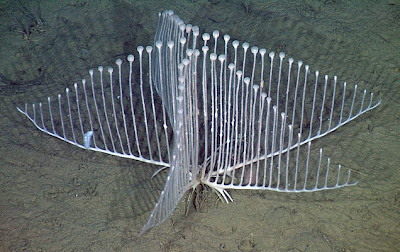Yep, you read that title right. This is not a
sculpture (or a musical instrument), but a newly discovered carnivorous
creature dubbed, appropriately, the harp
sponge. The story begins in 1995, when Jean Vacelet and Nicole
Boury-Esnault from the Centre of
Oceanology at France’s Aix-Marseille University identified a new species of
deep-sea sponge living in a shallow Mediterranean sea cave that actively
catches prey of small fish and crustaceans instead of absorbing bacteria and
organic particles through their bodies. Since then, 24 new species of
carnivorous sponges have been discovered. To learn about their behavior,
including how they reproduce, 2 remotely operated vehicles (ROVs) developed by
the Monterey Bay
Aquarium Research Institute descended...and made the latest discovery! The symmetrical
sponge - given the scientific name Chondrocladia lyra - was living off the
coast of California at depths of 3316–3399m. It can grow up to 37cm long with
as many as 6 vanes (the basic vertical and horizontal structures projecting
from the middle) that are covered in barbed hooks and spines that snare the
prey. Each of the vertical branches ends in a round spermatophore that releases
sperm in the hope that it will travel through the water and fertilize other
harp sponges in the area.
__________
The real thing:










No comments:
Post a Comment
You may add your comments here.